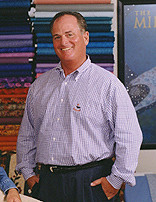 So many of us take fabric for granted. We adore it, we buy it, we use it, we cherish it, but how much do we know about how it's made? From the company that brings us previous designer guests like Lynette Jensen and Debbie Beaves, the President and CEO Rick Cohan of RJR Fabrics explains it for us! RJR is one of the world's leading manufacturers of high-quality fabric designed exclusively for the crafting of quilts and home sewing, with coordinated collections offering a variety in pattern, scale, and color.
So many of us take fabric for granted. We adore it, we buy it, we use it, we cherish it, but how much do we know about how it's made? From the company that brings us previous designer guests like Lynette Jensen and Debbie Beaves, the President and CEO Rick Cohan of RJR Fabrics explains it for us! RJR is one of the world's leading manufacturers of high-quality fabric designed exclusively for the crafting of quilts and home sewing, with coordinated collections offering a variety in pattern, scale, and color. The manufacturing process begins with the purchase of greige goods, which are unfinished 100% cotton fabrics in their raw state and not yet ready to be printed. Greige can be purchased from 36” to 135” wide. Greige comes in many different qualities, from many countries. The quality of the greige goods is measured by several factors including: the quality of the raw cotton, the length of the staple fiber, the yarn used in weaving and the thread count (the number of yarns per linear inch in the warp and filling directions). RJR purchases premium greige goods, the top quality in their country of origin.
The manufacturing process begins with the purchase of greige goods, which are unfinished 100% cotton fabrics in their raw state and not yet ready to be printed. Greige can be purchased from 36” to 135” wide. Greige comes in many different qualities, from many countries. The quality of the greige goods is measured by several factors including: the quality of the raw cotton, the length of the staple fiber, the yarn used in weaving and the thread count (the number of yarns per linear inch in the warp and filling directions). RJR purchases premium greige goods, the top quality in their country of origin. Before any printing is done, the fabric goes through a treatment process to purify the cloth. The treatment process includes singeing, desizing, bleaching, mercerization (strengthens and improves the yarns to accept color equally), and when necessary, framing. First the fabric is singed to remove any protruding fibers from the surface of the fabric. After singeing, the fabric enters a desizing bath where enzymes and detergents are used to saturate and soften the cloth to prepare it for printing. The desizing bath also stops any singeing sparks that might damage the cloth and removes the chemical stiffener applied to the fabric ends during the weaving process. The cotton fabric is then bleached a pure white to avoid any color distortion that may occur from the natural color of the cotton greige goods when dyes are introduced in the printing process. The fabric then goes through a final washing to remove all chemicals used in the above processes.
Before any printing is done, the fabric goes through a treatment process to purify the cloth. The treatment process includes singeing, desizing, bleaching, mercerization (strengthens and improves the yarns to accept color equally), and when necessary, framing. First the fabric is singed to remove any protruding fibers from the surface of the fabric. After singeing, the fabric enters a desizing bath where enzymes and detergents are used to saturate and soften the cloth to prepare it for printing. The desizing bath also stops any singeing sparks that might damage the cloth and removes the chemical stiffener applied to the fabric ends during the weaving process. The cotton fabric is then bleached a pure white to avoid any color distortion that may occur from the natural color of the cotton greige goods when dyes are introduced in the printing process. The fabric then goes through a final washing to remove all chemicals used in the above processes.  Finally the fabric is framed, a process which mechanically squares the fabric, aligning the yarns to secure uniform width and keep filling yarns on grain. The framing process is employed again after printing.
Finally the fabric is framed, a process which mechanically squares the fabric, aligning the yarns to secure uniform width and keep filling yarns on grain. The framing process is employed again after printing.Labels: Guest Quilting Writers